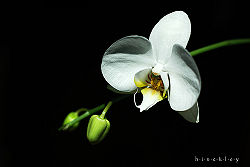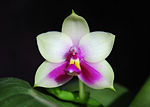Moth orchid
| Moth orchid |
|---|

|
| Scientific Classification |
|
| Species |
Phalaenopsis amboinensis |
Phalaenopsis orchids, or moth orchids, have lovely curving shapes and colorful blooms, especially hybrids which have striking and distinctive designs. Their large leaves are glossy and colored with elegant green. They naturally thrive in the rainforests of Asia, Indonesia, and northern Australia, but also do surprisingly well potted in homes or in greenhouses.
Orchids are known to be hard to grow and care for, so most growers would prefer not to face the challenge of raising one. Orchids are beautiful tropical plants and many people don't know that the most popular and beautiful orchid genus is actually the easiest to grow.
Anatomy
Moth Orchids are called such because their flowers have the appearance of a moth in flight. Most have petals with a very round shape. The entire flower is usually oval-shaped or sometimes star-shaped. Each orchid bloom has two (usually round) main petals, and three sepals behind them: two lateral sepals below and one dorsal sepal above. In the center or the bloom is a structure called the lip. It usually comes in a different color from the rest of the flower. The lip has two side lobes (that look like small petals) and a midlobe below with tendrils coming off of it. In between the side lobes is a structure called the callus. The lip is attached by the column. Moth Orchids have very broad leaves. The are thick, smooth and shiny, spreading out at the base of the plant. The leaves come in dark green or gray and green coloring, sometimes with a spotted look. From the leaves at the base sprouts a long, thin, curved stem. Along the end of the stem bloom rows of medium to large flowers.
Reproduction
Many moth orchids emit a fragrance along with their bright floral color in order to attract a pollinator. Different scents are meant to attract different pollinators. Orchids have the ability to only release their fragrance during the time of day when their common pollinator is out. For example, when one species is normally pollinated by bees, it is fragrant in the morning, as opposed to species that are pollinated by moths, which is fragrant at night. When a flower is pollinated, it wilts and begins the reproduction process. Orchids, being angiosperms (flowering plants) form seeds. Since moth orchids are mainly epiphytic, then they have small light-weight seeds that can easily be carried by wind to another tree rather than to the ground. Orchid seeds don't have an endosperm. They require the presence of mycorrhiza fungus in order to germinate. The fungus gives energy to the seed, preparing it to sprout into a seedling. [1]
Ecology
Moth orchids are found between South East Asia and Australia. They grow in rainforest climates and do well in warm humid environments. Moth Orchids are epiphytic which means that they do not require soil to grow. Mostly they grow on the trunks and branches of trees under the shade of the canopy. Phalaenopsis don't lose their leaves and bloom about twice a year, usually in spring or summer. The flowers last eight weeks to three months and then will not bloom for another twelve to sixteen months. A moth orchid seedling will grow for five to seven years before its first bloom. Flower spikes (stems) can appear at any time during the year, but normally start growing in the fall. About three months after the stem is fully grown, the buds will develop. These orchids require a time of colder temperatures than they are used to before a flower spike will develop (about three weeks below 16 degrees C). Moth orchids are very hardy plants. They can go with out watering for a month, and though they need general temperatures around sixteen to twenty-four degrees C, they can survive a drop to as low as ten degrees C without suffering damage. Water is stored in their fleshy leaves, but if conditions are both hot and dry, then they will lose moisture through evaporation. They endure hot weather better in higher humidity.
Horticulture
Moth Orchids are becoming extremely popular as house plants. They are very simple to grow, unlike other orchids species, and are hardy so that even the most forgetful grower can keep them alive. The elegant shapes and bright colors and designs of their flowers make them a beautiful and sophisticated addition to any home decor. Phalaenopsis need to be kept in a warm room. Long periods of colder temperatures will cause yellowing in the foliage. Create humidity by misting them (always allowing them to dry before night) or setting them on top of stones in water, so that they do not sit directly in the water. Being epiphytic, they are used to thorough drainage around their roots. Phalaenopsis roots absorb air as well and too much water will cause them to suffocate. Keep your moth orchid in indirect light because wild orchids are used to shade. Too much sun will burn them and not enough will cause them to wilt. Water it under the faucet once a week and let it drain completely to keep from rotting. After a spike is done flowering, you can leave it and more smaller flowers might develop, or you can prune it back and a new stem will grow. Phalaenopsis have roots that grow up out of the ground, but this does not mean that it is growing out of its pot. They only need to be repotted about every three years.
Gallery
Moon Orchid
(P. amabilis )
 Browse |
References
- link title Author. Publisher.
- link title Author. Publisher.
- link title Author. Publisher.




